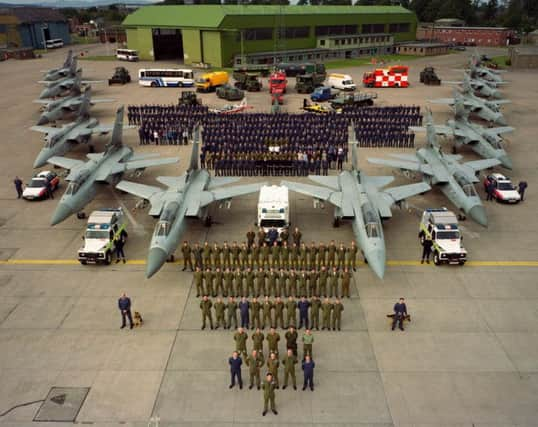The Ayrshire airfield that helped shape the fledgling RAF


With the German biplanes arriving on the back of the Zeppelin air raids, which counted a Leith whisky bond among its strikes, a new urgency surrounded the future strength of Britain’s aerial operations.
First World War pilots, who initially used plane for reconnaissance, adopted a fighting role as combat intensified, leading to recognition within the military of the ability of aerial operations to devastate enemy lands on a vast scale.
Advertisement
Hide AdAdvertisement
Hide AdIn Scotland, work was already under way on accelerating the country’s air power, with flat coastal areas becoming key to a new chapter in military aviation.
It did not, at first, come easily. A disastrous attempt to build an aerial warfare and gunnery training school at Loch Doon in Ayrshire – allegedly costing up to £3 million – was abandoned after it came to light the ground was too boggy for planes to land.
Turnberry Hotel and Golf Course was requisitioned as a site for another school, with Ayr Racecourse also used to create a new generation of fighter pilots. Both merged to form the No. 1 Fighting School which become the biggest training school in Britain after the formation of the RAF on April 1, 1918.
Lieutenant General Sir David Henderson, from Glasgow, the director general of military aeronautics at the Royal Flying Corps (RFC,) had been charged to lead the the tricky amalgamation of the two separate strands of Britain’s air service amid growing dissatisfaction that operations were split between the army and the navy.
Under his leadership, the Royal Flying Corps and the Royal Naval Air Service was amalgamated 100 years ago tomorrow. The Women’s Royal Air Force was also created to retain skills and expertise developed in the old army and naval branches.
Dr Dan Paton is the curator of the Montrose Air Station Heritage Centre in Angus, the first operational military station in the UK, from where the Royal Flying Corps was led to war in 1914.
He described the amalgamation as a “historic and remarkable event” give the short time in which aviation had developed.
Dr Paton said: “The first manned flight in 1903 covered a few hundred yards. Ten years on and No2 Squadron took 13 days to fly from Montrose to Farnborough. Yet, only five years later a new member of the armed forces was created with the same status as the British Army and the Royal Navy.”
Advertisement
Hide AdAdvertisement
Hide AdA new thrust was placed on training, with torpedo bombing techniques developed at the old East Fortune naval airfield near North Berwick, the home to aircraft such as Sopwith Pups and the giant airships that patrolled the seas searching for the enemy.
On the ground, new uniforms, medals and ranks were developed to forge the identity of the unified service.
Captain John Todd, a Scottish “ace” from Falkirk, who is credited with 18 aerial victories, was among the first pilots to hold both the Military Cross issued by the RFC and the new Distinguished Flying Cross introduced by the RAF in 1918.
Designing a new uniform took longer, with pilots eventually swapping the simple RFC khakis for the smart blue of the RAF.
At Turnberry, the gunnery school was regarded as a type of finishing school for pilots and, with the old hotel chefs kept on site, it was viewed as a very comfortable placement, according to researcher Margaret Morrell, who is writing a book on the Ayrshire airfield.
She added: “The Royal Flying Corps did send men home from the front line on operational leave to instruct at Turnberry but they were coming back absolutely exhausted and shell shocked. These instructors nicknamed the students ‘The Hun’ as they wrecked more aircraft that the enemy.”
Tom Barclay, a local historian and librarian from Ayr, said a number of World War One “aces” were seconded to the Ayrshire coast to share their skills following the merger.
They included Major James “Mac” McCudden, who claimed 56 victories and received more awards for gallantry during World War One than any other British airman.
Advertisement
Hide AdAdvertisement
Hide AdHe taught at Turnberry between March and July 1918. Shortly after leaving the Ayrshire coast, he died in a plane crash in the north of France, aged just 23.
Such was the impact of the Turnberry airfield that the people of Kirkoswald Parish put up a memorial cross to honour its airmen who died during the First World War, with 39 men listed. Included on the memorial is Captain Ian Henderson, the son of Lt General Sir David Henderson, who died in a flying accident close to the airfield in April 1918 while testing out a new plane.
The death of his son is said to have deeply affected Sir David, who requested his own ashes be placed alongside his son’s body at Doune Cemetery, Girvan.
Mr Barclay said: “Lt Gen Henderson died aged 59 and it is said that the strain that he had been under at the time of the creation of the RAF led to his early death in 1921.
“It is very unusual for someone who died such a time after the war ended to be remembered on a Commonwealth War Grave.
“It is also very unusual for a father and son to be named on the same Commonwealth War Grave stone, but that was the significance of Henderson’s contribution.
“Indeed Lord Trenchard himself, the first Chief of Air Staff, described Henderson as the true father of the RAF.”
In a further singling out of Henderson’s role in the creation of the RAF, flowers will be laid at his gravestone today by the RAF Association to commemorate the 100th anniversary.